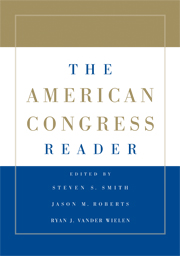Book contents
- Frontmatter
- Contents
- THE AMERICAN CONGRESS READER
- PART I THE AMERICAN CONGRESS: MODERN TRENDS
- PART II REPRESENTATION AND LAWMAKING IN CONGRESS: THE CONSTITUTIONAL AND HISTORICAL CONTEXT
- PART III CONGRESSIONAL ELECTIONS AND POLICY ALIGNMENTS
- PART IV MEMBERS, GOALS, RESOURCES, AND STRATEGIES
- PART V PARTIES AND LEADERS
- PART VI THE STANDING COMMITTEES
- PART VII THE RULES OF THE LEGISLATIVE GAME
- PART VIII THE FLOOR AND VOTING
- PART IX CONGRESS AND THE PRESIDENT
- PART X CONGRESS AND THE COURTS
- 34 Senate Voting on Supreme Court Nominees
- 35 From Abe Fortas to Zoë Baird
- PART XI CONGRESS, LOBBYISTS, AND INTEREST GROUPS
- PART XII CONGRESS AND BUDGET POLITICS
- PART XIII FURTHER READINGS ON CONGRESSIONAL POLITICS
34 - Senate Voting on Supreme Court Nominees
A Neoinstitutional Model
Published online by Cambridge University Press: 05 June 2012
- Frontmatter
- Contents
- THE AMERICAN CONGRESS READER
- PART I THE AMERICAN CONGRESS: MODERN TRENDS
- PART II REPRESENTATION AND LAWMAKING IN CONGRESS: THE CONSTITUTIONAL AND HISTORICAL CONTEXT
- PART III CONGRESSIONAL ELECTIONS AND POLICY ALIGNMENTS
- PART IV MEMBERS, GOALS, RESOURCES, AND STRATEGIES
- PART V PARTIES AND LEADERS
- PART VI THE STANDING COMMITTEES
- PART VII THE RULES OF THE LEGISLATIVE GAME
- PART VIII THE FLOOR AND VOTING
- PART IX CONGRESS AND THE PRESIDENT
- PART X CONGRESS AND THE COURTS
- 34 Senate Voting on Supreme Court Nominees
- 35 From Abe Fortas to Zoë Baird
- PART XI CONGRESS, LOBBYISTS, AND INTEREST GROUPS
- PART XII CONGRESS AND BUDGET POLITICS
- PART XIII FURTHER READINGS ON CONGRESSIONAL POLITICS
Summary
Cameron, Cover, and Segal consider the factors that lead senators to vote for or against a president's Supreme Court nominees. They find that nominees considered to be higly qualified and closer to the policy positions of a senator's state are more likely to receive a positive vote.
Roll call voting in the U.S. Senate on nominees to the Supreme Court presents political scientists with an empirical puzzle and a theoretical challenge. The empirical puzzle stems from a curious pattern in the nomination politics of recent decades. In some cases, as shown in Table 34.1, the Senate routinely confirms the nominee. In these cases, liberal senators vote for conservative nominees and conservative senators vote for liberal nominees. For example, the most liberal members of the Senate recently voted to confirm judicial conservative Antonin Scalia. But on other occasions – including 9 of the 20 post-Brown-v.-Board of Education confirmations – the confirmation becomes extremely contentious. In these cases many or even most senators vote against the nominee, and voting becomes ideologically polarized. The rejection of Robert Bork illustrates this case.
We therefore face some puzzling questions: Why are some votes consensual? Why are some votes contentious? And what determines voting decisions in both cases? Satisfactory answers to these questions must explain the apparent switching process between the consensual and conflictual votes and the variance within the conflictual votes.
- Type
- Chapter
- Information
- The American Congress Reader , pp. 383 - 388Publisher: Cambridge University PressPrint publication year: 2008

